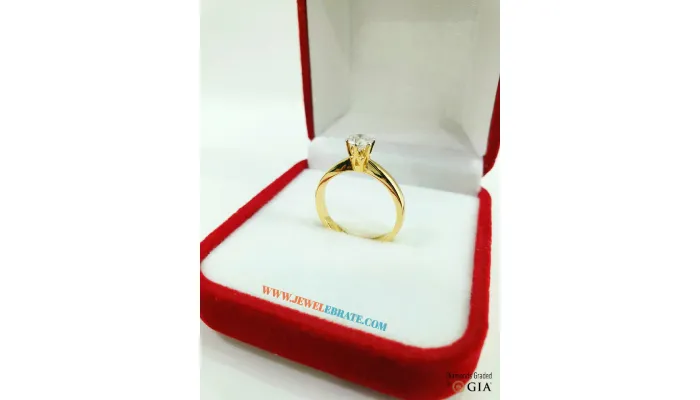Caring for your diamond engagement ring requires a mix of regular attention and smart habits. Visiting a jeweler once or twice a year helps check the setting and gives your ring a professional polish, keeping it sparkling. At home, you can clean it gently with warm soapy water and a soft toothbrush every few weeks to remove buildup. It’s important to avoid harsh chemicals like bleach or ammonia since they can damage the metal band. Also, take off your ring during activities like exercising, swimming, or cooking to prevent damage or loss. When not wearing it, store the ring safely in a designated dish or soft pouch to avoid scratches and keep it secure over time.
Professional Maintenance and Regular Checkups
It’s important to have your diamond engagement rings checked by a professional jeweler at least once or twice a year. During these visits, the jeweler will carefully inspect the prongs and setting to ensure the diamond is secure and show no signs of loosening. Professional cleaning goes beyond what home routines can achieve, removing dirt and buildup that dull the sparkle. You can also request polishing during these checkups to restore the metal’s shine and smooth out minor scratches, keeping your ring looking fresh. If any damage or loose stones are detected, it’s best to get repairs done promptly to avoid losing the diamond or causing further harm. Keeping a record of all maintenance visits and repairs helps you track the ring’s condition over time. Some jewelers offer warranty or maintenance plans that include routine checkups and cleanings, which can provide peace of mind. Don’t wait to schedule a professional inspection if you notice the ring feels loose or the diamond wobbles, as early detection can prevent costly repairs. These checkups can also catch early signs of metal wear or thinning bands. To stay fully prepared, consider combining maintenance visits with jewelry appraisal updates, which are useful for insurance purposes and give you an accurate valuation of your cherished ring.
How to Clean Your Diamond Ring at Home?
To clean your diamond ring at home safely, start by mixing warm water with a few drops of mild dish soap like Dawn to create a gentle cleaning solution. Soak your ring in this mixture for 10 to 20 minutes to help loosen any dirt or oils. After soaking, use a soft-bristled toothbrush to carefully scrub the diamond and its setting, paying special attention to hard-to-reach spots where grime tends to collect. Once cleaned, rinse the ring thoroughly under warm running water to remove all soap residue. Dry it with a soft, lint-free cloth to prevent scratching the metal, avoid abrasive cloths or paper towels, as they can cause tiny scratches. For best results, clean your ring every 2 to 4 weeks depending on how often you wear it and your daily activities. If you want a quick refresh, rinsing under water and wiping with a soft cloth can be done more frequently. Avoid using toothpaste or baking soda since they can be too harsh for your ring’s metal and setting. If you ever feel uncertain about cleaning your ring yourself, professional cleanings during maintenance visits are recommended to keep it looking its best.
- Use warm water mixed with a few drops of mild dish soap, such as Dawn, to prepare a cleaning solution.
- Soak your ring in the solution for 10 to 20 minutes to loosen dirt and oils.
- Gently scrub the diamond and setting with a soft-bristled toothbrush, focusing on hard-to-reach areas.
- Rinse the ring thoroughly under warm running water to remove soap residue.
- Dry the ring with a soft, lint-free cloth to avoid scratching the metal.
- Avoid using abrasive cloths or paper towels which can cause micro-scratches.
- Clean your ring every 2 to 4 weeks depending on how often you wear it and your daily activities.
- For quick refreshes, rinsing under water and wiping with a cloth can be done more frequently.
- Avoid using toothpaste or baking soda as they can be too abrasive for the metal and setting.
- If unsure about homemade cleaning, follow up with professional cleaning during maintenance visits.
Avoid Harsh Chemicals That Harm Your Ring
Harsh chemicals like bleach, ammonia, and chlorine can seriously damage your diamond engagement ring. These substances can weaken the metal band, especially white gold, and even loosen the setting holding your diamond in place. It’s best to remove your ring before using household cleaners or detergents containing strong chemicals. Also, avoid exposing your ring to beauty products such as hairspray, lotions, and perfumes, as they can leave residues that dull your diamond’s natural shine. If you need to handle any chemicals, wearing gloves is a smart way to protect your ring from accidental exposure. Swimming pools and hot tubs contain chlorine, which can wear down some metals over time, so take off your ring before taking a dip. Be careful with acetone or nail polish remover as well, since they can harm certain metals and stones. Never soak your ring in any chemical solutions that aren’t designed specifically for jewelry cleaning. If your ring accidentally comes into contact with any harsh substance, rinse it thoroughly with warm water to minimize damage. Paint, glue, and other sticky materials can also stain or harm your ring, so keep your jewelry away from these as much as possible. Lastly, regularly check your ring for any signs of discoloration or damage caused by chemicals to catch problems early.
Safe Handling During Daily Activities
To keep your diamond engagement ring in top condition, it’s important to handle it carefully during your daily routine. Always remove your ring before exercising, as activities like weightlifting or cycling can bend or damage the band. Showering or bathing with your ring on isn’t ideal either, since soap residue can make it slippery and increase the risk of losing it. Avoid wearing your ring while swimming in pools or the ocean because chlorine and saltwater can harm the metal and weaken the setting. When cooking or cleaning, take the ring off to prevent buildup of oils, food particles, and harsh chemicals that can dull its shine. Heavy manual work or gardening can cause scratches and dents, so it’s best to remove your ring during these tasks. If you prefer not to go without your ring during workouts, consider wearing it on a necklace temporarily. When handling your ring, touch the band rather than the diamond to reduce oil and dirt on the stone. Be careful not to knock your ring against hard surfaces, as this can loosen the setting or chip the diamond. Also, be mindful of activities that cause your fingers to swell, since a tight ring can be uncomfortable and risky. When you’re not wearing your ring, store it safely in a designated spot to prevent accidental damage during daily activities.
Best Ways to Store Your Engagement Ring
To keep your diamond engagement ring safe and looking its best, start by designating specific ring dishes or trays around your home. These provide a secure spot to place your ring when you take it off, reducing the chance of misplacing it. For longer periods, like during travel or vacations, store your ring in a soft-lined box or a silk pouch to protect it from scratches and other damage. Avoid putting your diamond ring together with other jewelry pieces, especially other rings, since diamonds can scratch each other due to their hardness. Using jewelry organizers with separate compartments is a smart way to keep your ring secure and easy to find. If you have multiple rings, labeling each compartment can help prevent confusion and accidental mixing. Keep your ring away from direct sunlight and extreme temperatures, as these conditions can harm both the metal and the stone over time. It’s also best to avoid storing your ring in bathrooms or kitchens where moisture and chemicals are common, since these can dull the metal or loosen the setting. For extended storage, consider a small safe or lockbox to provide extra security. Lastly, regularly check your storage containers for dirt or debris that could scratch your ring, ensuring a safe and clean environment for your precious jewelry.
Ensuring the Right Size and Fit
Having your engagement ring professionally sized is key to keeping it comfortable and secure. A ring that’s too large can easily slip off your finger and get lost, while one that’s too small may feel tight and cause discomfort. Keep in mind that your fingers aren’t a constant size, they can swell or shrink due to temperature changes, weight shifts, or pregnancy. For example, fingers tend to be a bit larger during warmer months, so getting your ring sized then can help avoid a tight fit later. If your ring feels loose or tight between visits to the jeweler, sizing beads or ring adjusters can offer a temporary solution without damaging the band. Never force a ring that’s too small onto your finger, as this can harm the metal or cause swelling. Since resizing options vary depending on the metal and setting, it’s best to ask your jeweler about what’s possible before making any changes. Also, resizing can sometimes impact the ring’s design or strength, so professional advice is essential. Finally, keep a record of your ring size and any resizing history for future reference, ensuring your ring always fits just right.
Polishing and Caring for the Metal Band
To keep your engagement ring’s metal band looking its best, professional polishing every few years is key. This helps restore the original shine and removes minor scratches that happen with daily wear. If your ring has a white gold band, it may need rhodium plating to maintain its bright white finish, since the plating can wear off over time. Avoid using harsh polishing cloths or abrasive materials at home, as they can damage the metal’s surface. Instead, gently clean your ring regularly with mild soap and water to help preserve its polish and reduce how often you need professional care. During your jeweler visits, have them inspect the band for thinning or bending to catch any issues early. Also, be mindful to avoid rough surfaces and exposure to abrasive chemicals, which can dull the finish. When not wearing your ring, store it separately in a soft pouch or lined box to prevent scratches from other jewelry. If your ring features engravings or delicate designs, it’s best to leave polishing to the professionals to ensure those details stay intact. Finally, talk to your jeweler about the best care routine and polishing frequency based on your metal type and lifestyle, so your ring remains beautiful for years to come.
Insuring Your Ring and Keeping Documentation
To protect your diamond engagement ring, start by getting it appraised by a certified professional who can accurately determine its value. This appraisal will be essential when purchasing insurance coverage, which safeguards your ring against loss, theft, damage, or mysterious disappearance. You can either add your ring to your homeowner’s or renter’s insurance policy or opt for a separate jewelry insurance plan, depending on what offers the best coverage. Keep all important documents in a safe place, including receipts, appraisal certificates, warranty papers, and certification documents from your jeweler such as GIA or other grading reports that confirm authenticity. Taking clear photos of your ring from different angles adds another layer of protection for insurance claims. Remember to update your insurance appraisal every few years or after any significant changes like repairs or resizing. Notify your insurer promptly about any maintenance or modifications, and always keep copies of any work done on the ring. Before finalizing your insurance, make sure you understand the terms and coverage limits to avoid surprises later on.
Additional Tips for Wearing and Caring
Avoid wearing your diamond engagement ring to bed, as fingers can swell overnight and increase the risk of bending the band or causing discomfort. Establish a consistent spot at home to place your ring when you take it off, like a small dish or jewelry tray, to reduce the chance of losing it. Always remove your ring before applying lotions or creams, since residues can build up on the diamond and dull its sparkle. Check your ring occasionally during the day to make sure it still feels secure and comfortable, especially if you have an active lifestyle. If you do lead a very active daily routine, consider choosing a sturdier band or setting that can better withstand wear and tear. Be careful when wearing your ring around pets or young children, as they might accidentally pull or knock it, risking damage. Use gentle hand soaps and dry your hands carefully to help maintain the ring’s cleanliness and metal condition. Avoid frequently twisting or adjusting your ring, because this can weaken the setting over time. If you wear your ring daily in varied conditions, scheduling regular professional inspections can catch issues early. Lastly, if you notice any discomfort or changes in your finger size, don’t hesitate to consult a jeweler to ensure your ring fits properly and remains safe to wear.
Using Ultrasonic Cleaners and Steamers Safely
Ultrasonic cleaners are great at removing dirt and grime from diamond rings, but they can loosen stones if the setting isn’t strong enough. Steam cleaners help bring back sparkle, but you need to be careful because heat can damage some metals or other gemstones. Unless you’re sure your ring is durable and the stones are secure, it’s best to avoid using ultrasonic or steam cleaners at home. Always check with your jeweler first, especially if your ring has gemstones besides diamonds. Professional jewelers use controlled ultrasonic and steam machines that are safer for your ring. Avoid ultrasonic cleaning on rings with fragile or treated stones since the vibrations can cause damage. Steam cleaning should never be done on rings with glued settings, and you should let your ring cool completely before handling it after steaming. These cleaning methods are best left to professionals and used as part of regular maintenance, not frequent home cleaning. If you do have a home ultrasonic cleaner, follow the manufacturer’s instructions carefully to prevent accidental damage.

Mary Burns is a dedicated writer focusing on health and fitness topics. With a passion for promoting wellness and vitality, Mary shares her knowledge and expertise through engaging and informative blog posts.




